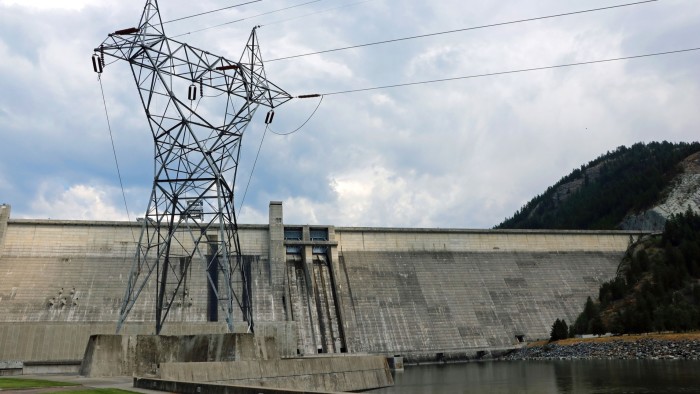Prolonged drought and extreme weather are forcing Canada to import electricity from the US after nearly two decades of exporting excess hydropower to its neighbour.
Canada is the world’s third-largest producer of hydroelectricity, behind Brazil and China, and hydropower accounts for close to 62 per cent of its total domestic electricity generation, according to official data.
But surging power demand linked to digitisation and the reshoring of manufacturing has collided with reduced electricity supply because of drought, complicating Canada’s energy transition and its trade relationship with its powerful neighbour.
Canada’s official drought monitor shows large swaths of the country are experiencing severe or moderate drought, in particular its top hydropower-producing provinces of Québec, British Columbia and Manitoba.
In the past these provinces had enough spare hydro electricity to sell to the US. But Canada is now importing power from its southern neighbour, according to US Energy Information Administration data released last week that showed the trend reversed between September 2023 and June 2024.
“Drought conditions reduced inflow to reservoirs in western Canada,” the EIA report states. “In addition, lower natural gas prices in the US reduced power prices, making US electricity more competitive.”
The challenge facing Canada’s hydropower sector is mirrored in many other parts of the world, with drought causing global hydroelectricity generation to slump to a five-year low last year, according to the UK Energy Institute’s Statistical Review of World Energy.
The International Energy Agency said severe droughts in China, the US and other nations had resulted in an “exceptional shortfall of hydropower” in 2023. The switch to fossil fuel alternatives to plug the gap was responsible for more than 40 per cent of the rise in global greenhouse gas emissions last year, it said.
This year the US is forecast to generate the least amount of electricity from hydropower since 2001 because of “extreme and exceptional” drought conditions, according to the EIA.
“Hydropower is absolutely climate dependent,” said Sean Turner, a hydropower expert at the US government-funded Oak Ridge National Laboratory.
“The trend is going to vary depending on where you are in the world and in many cases that trend remains highly uncertain, he said, adding “temperature increase will tend to drive increasing evaporation in a river basin”.
In March, Statistics Canada, the official data agency, reported electricity generated in Canada fell 3.9 per cent year-on-year to 615.3mn megawatt-hours (MWh) in 2023, the lowest level since 2016. “Nearly all of the decline in electricity generation in 2023 was weather-related,” the agency said.
Income from electricity exports to the US also dropped to US$3.2bn in 2023, nearly 30 per cent less than in 2022. US electricity exports to Canada increased US$454.5mn in 2023 to US$1.2bn, the EIA said.
As well as hitting US electricity exports, Canada’s drop in hydropower production could have political ramifications.
Heather Exner-Pirot, a policy director at the Macdonald-Laurier Institute, an Ottawa-based think-tank, said energy is expected to be an important part of negotiations beginning in 2026 for the renewal of the free trade agreement between Canada, the US and Mexico.
“The collapse of our electricity exports to the US could not have happened at a worse time,” she said, adding that the election of Donald Trump could complicate trade talks at a time when Canada needed as much leverage with Washington as possible.
Exner-Pirot acknowledged the downturn in hydropower generation could be cyclical and wetter years in the future would reinvigorate exports but said government regulations were slowing the number of new projects coming online.
“As power demand goes up everywhere, for the first time in a long time, Canada needs to get better at building infrastructure,” she said.
While weather patterns have always affected hydropower production, the fluctuations are expected to become less predictable and more extreme because of climate change, say experts. In the long run, this could mean Canada’s hydroelectricity generation will increase.
National Resources Canada said: “These annual variations in exports are not a new phenomenon. However, modelling of climate impacts also suggests that the annual level of precipitation could increase in Canada’s hydroelectricity-producing jurisdictions.”
However, in the short term, utilities are having to navigate uncertainty. Allan Danroth, chief executive of Manitoba Hydro, which operates in Canada’s Lake Winnipeg region and reported a C$157mn loss in 2023 following two years of drought, said the company was at “the mercy of mother nature” when it comes to rain.
“Low water conditions resulted in less excess energy being available to sell in wholesale markets, and the need to import power to meet customers’ requirements in Manitoba,” he said in a statement last month.
Renewables could offer a solution for maintaining Canada’s electricity export levels, say some experts. Will Noel, an electricity analyst with the Pemba Institute, a think-tank in Vancouver, said provinces need to co-ordinate better to free up renewable energy for sales to the US in times of decreased hydropower capacity.
“When the sun is shining and the wind is blowing, grids should be using that low-cost energy and saving hydro resources for other times since they also effectively work as energy storage or trade,” he said.
Additional Reporting Amanda Chu in New York
Read the full article here

